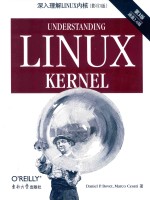

深入理解Linux内核 第3版 影印版PDF电子书下载
- 电子书积分:24 积分如何计算积分?
- 作 者:Daniel P.Bovet,Marco Cesati
- 出 版 社:南京:东南大学出版社
- 出版年份:2019
- ISBN:9787564183417
- 页数:923 页
1.Introduction 1
Linux Versus Other Unix-Like Kernels 2
Hardware Dependency 6
Linux Versions 7
Basic Operating System Concepts 8
An Overview of the Unix Filesystem 12
An Overview of Unix Kernels 19
2.Memory Addressing 35
Memory Addresses 35
Segmentation in Hardware 36
Segmentation in Linux 41
Paging in Hardware 45
Paging in Linux 57
3.Processes 79
Processes, Lightweight Processes, and Threads 79
Process Descriptor 81
Process Switch 102
Creating Processes 114
Destroying Processes 126
4.Interrupts and Exceptions 131
The Role of Interrupt Signals 132
Interrupts and Exceptions 133
Nested Execution of Exception and Interrupt Handlers 143
Initializing the Interrupt Descriptor Table 145
Exception Handling 148
Interrupt Handling 151
Softirqs and Tasklets 171
Work Queues 180
Returning from Interrupts and Exceptions 183
5.Kernel Synchronization 189
How the Kernel Services Requests 189
Synchronization Primitives 194
Synchronizing Accesses to Kernel Data Structures 217
Examples of Race Condition Prevention 222
6.Timing Measurements 227
Clock and Timer Circuits 228
The Linux Timekeeping Architecture 232
Updating the Time and Date 240
Updating System Statistics 241
Software Timers and Delay Functions 244
System Calls Related to Timing Measurements 252
7.Process Scheduling 258
Scheduling Policy 258
The Scheduling Algorithm 262
Data Structures Used by the Scheduler 266
Functions Used by the Scheduler 270
Runqueue Balancing in Multiprocessor Systems 284
System Calls Related to Scheduling 290
8.Memory Management 294
Page Frame Management 294
Memory Area Management 323
Noncontiguous Memory Area Management 342
9.Process Address Space 351
The Process’s Address Space 352
The Memory Descriptor 353
Memory Regions 357
Page Fault Exception Handler 376
Creating and Deleting a Process Address Space 392
Managing the Heap 395
10.System Calls 398
POSIX APIs and System Calls 398
System Call Handler and Service Routines 399
Entering and Exiting a System Call 401
Parameter Passing 409
Kernel Wrapper Routines 418
11.Signals 420
The Role of Signals 420
Generating a Signal 433
Delivering a Signal 439
System Calls Related to Signal Handling 450
12.The Virtual Filesystem 456
The Role of the Virtual Filesystem (VFS) 456
VFS Data Structures 462
Filesystem Types 481
Filesystem Handling 483
Pathname Lookup 495
Implementations of VFS System Calls 505
File Locking 510
13.I/O Architecture and Device Drivers 519
I/O Architecture 519
The Device Driver Model 526
Device Files 536
Device Drivers 540
Character Device Drivers 552
14.Block Device Drivers 560
Block Devices Handling 560
The Generic Block Layer 566
The I/O Scheduler 572
Block Device Drivers 585
Opening a Block Device File 595
15.The Page Cache 599
The Page Cache 600
Storing Blocks in the Page Cache 611
Writing Dirty Pages to Disk 622
The sync(), fsync(), and fdatasync() System Calls 629
16.Accessing Files 631
Reading and Writing a File 632
Memory Mapping 657
Direct I/O Transfers 668
AsynchronousI/O 671
17.Page Frame Reclaiming 676
The Page Frame Reclaiming Algorithm 676
Reverse Mapping 680
Implementing the PFRA 689
Swapping 712
18.The Ext2 and Ext3 Filesystems 738
General Characteristics of Ext2 738
Ext2 Disk Data Structures 741
Ext2 Memory Data Structures 750
Creating the Ext2 Filesystem 753
Ext2 Methods 755
Managing Ext2 Disk Space 757
The Ext3 Filesystem 766
19.Process Communication 775
Pipes 776
FIFOs 787
System V IPC 789
POSIX Message Queues 806
20.Program Execution 808
Executable Files 809
Executable Formats 824
Execution Domains 827
The exec Functions 828
A.System Startup 835
B.Modules 842
Bibliography 852
Source Code Index 857
Index 905
- 《微笑 影印本》N.达列基作 1947
- 《金丝髪 侦探小说 影印本》格离痕著 1914
- 《戊戌六君子遗集 影印本 上》谭嗣同撰 2019
- 《深入推进自我革命》任仲文 2019
- 《行测言语理解与表达》李永新主编 2019
- 《深入浅出区块链核心技术与项目分析》梁伟 2019
- 《深入浅出Ruby 影印版》Jay McGavren 2017
- 《方程组实数解的几何方法 影印版》Frank Sottile 2018
- 《比较蛋白质组学的生物信息学 影印版》(美)C·H·Wu 2016
- 《棘手孩子 理解孩子的天生气质》(美国)斯坦利·图雷克,莱斯利·唐纳 2019
- 《深入理解Linux内核 第3版 影印版》Daniel P.Bovet,Marco Cesati 2019
- 《颈淋巴结清扫术实用指南》(意)马可·卢乔尼(Marco Lucioni)著;刘良发等译 2019
- 《NARRATIVE AND REPRESENTATION IN THE POETRY OF WALLACE STEVENS》DANIEL R.SCHWARZ 2222
- 《鲁滨孙漂流记》(英)丹尼尔·笛福(Daniel Defoe)著 2012
- 《传染病信息学与生物监测》Daniel,Zeng等著;DanielZeng,HsinchunChen,MarkThurmong等编宋宏彬,王立贵,曹志冬等译 2014
- 《经济学人权威预测:2050趋势巨流》丹尼尔·富兰克林(DANIEL FRANKLIN),约翰·安德鲁斯(JOHN ANDREWS)编著;罗耀宗译 2012
- 《键盘入门教程 电钢琴、电子琴、合成器均适用 2》丹尼尔·斯科特(Daniel Scott)著 2008
- 《鲁宾逊漂流记》(英)笛福(Daniel,D.)著 2009
- 《脱胎换骨的管理人》(美)丹尼尔·阿洛兹(Daniel L. Araoz),(美)威廉·萨顿(Willeam S. Sutton)著;舒强译 1998
- 《精通 CGI编程》(美)(D.J.伯林)(Daniel J.Berlin)等著;丁一强等译 1998
